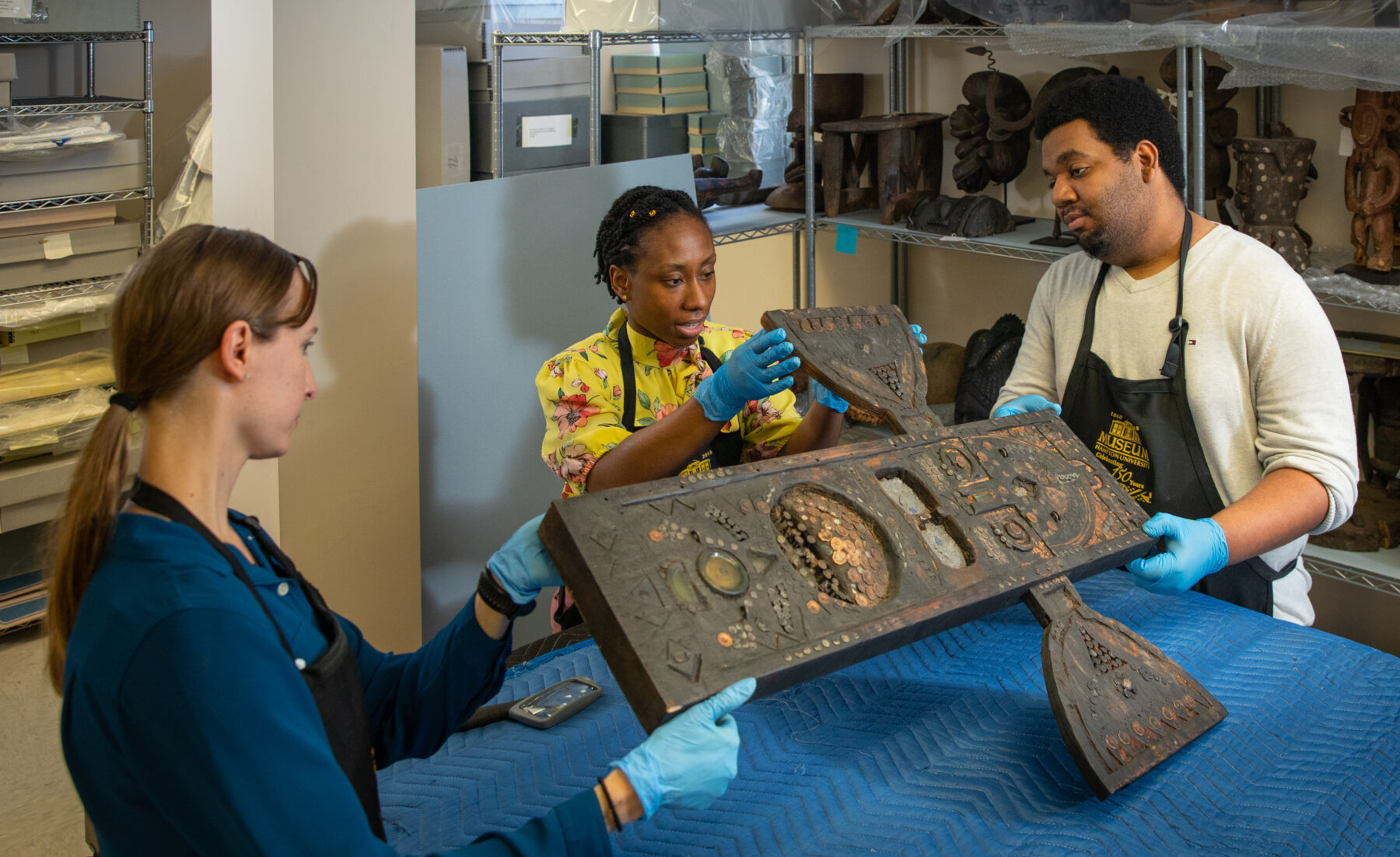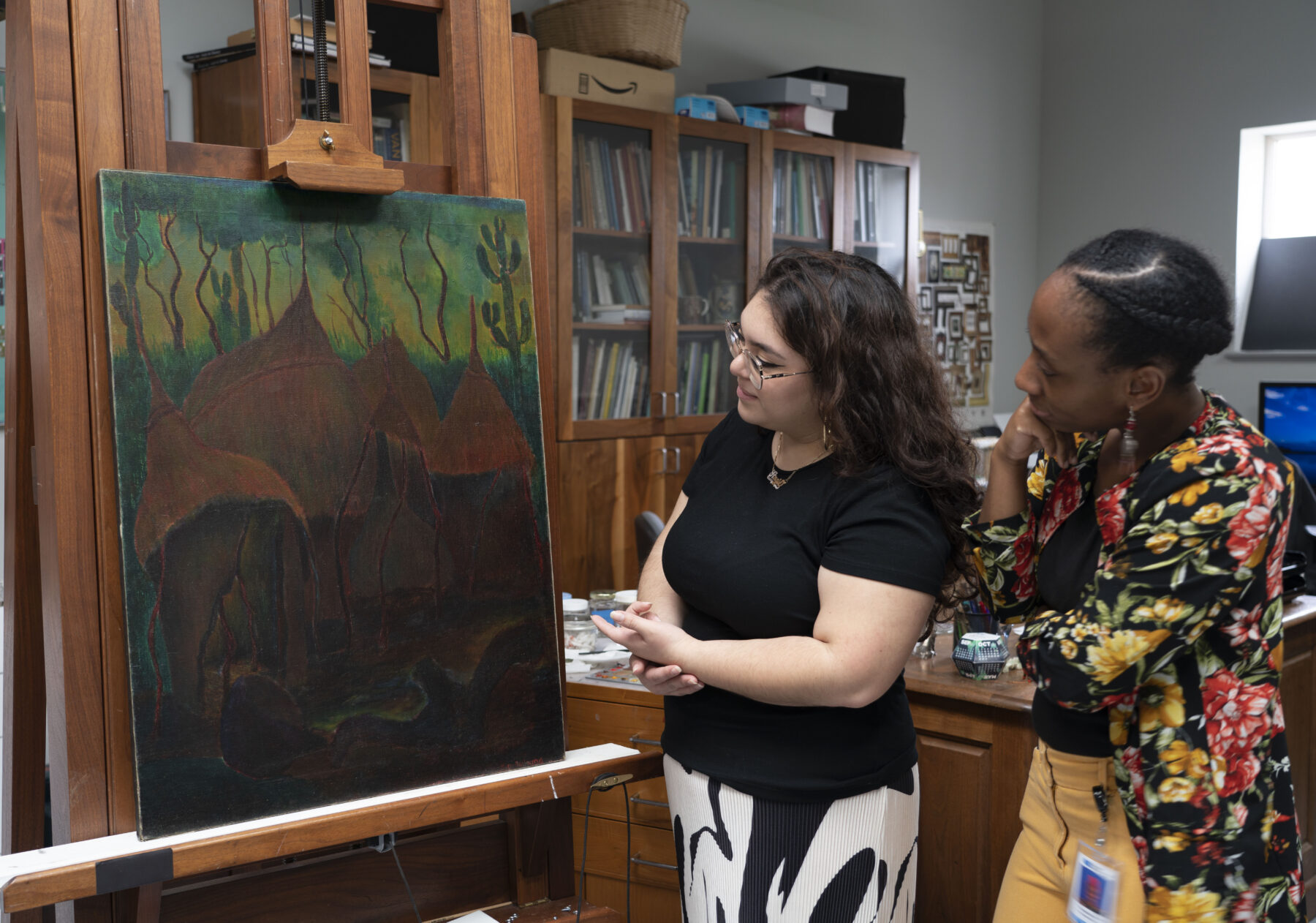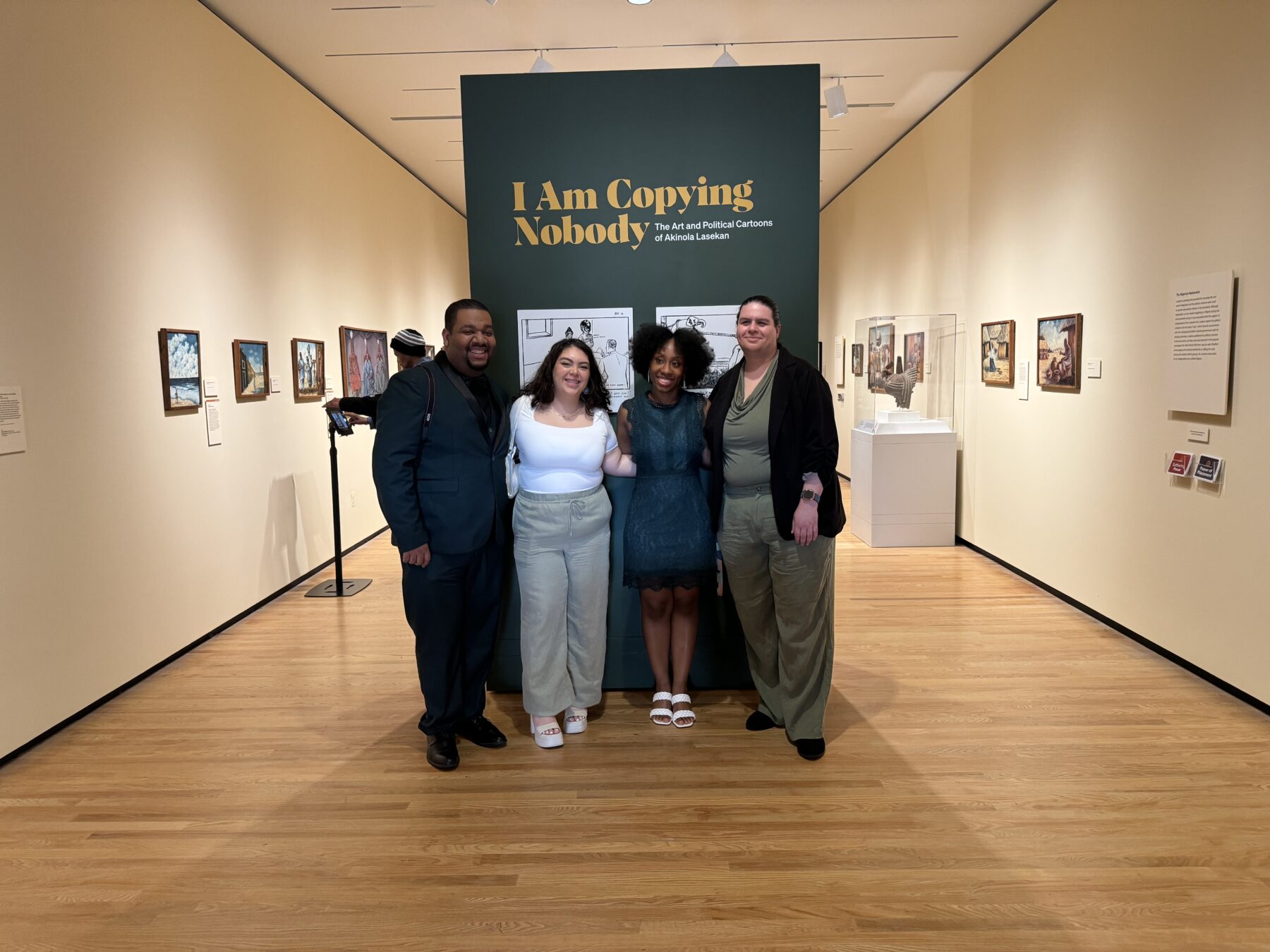Christ in the Manger: Virginia’s Most Endangered Artifact?

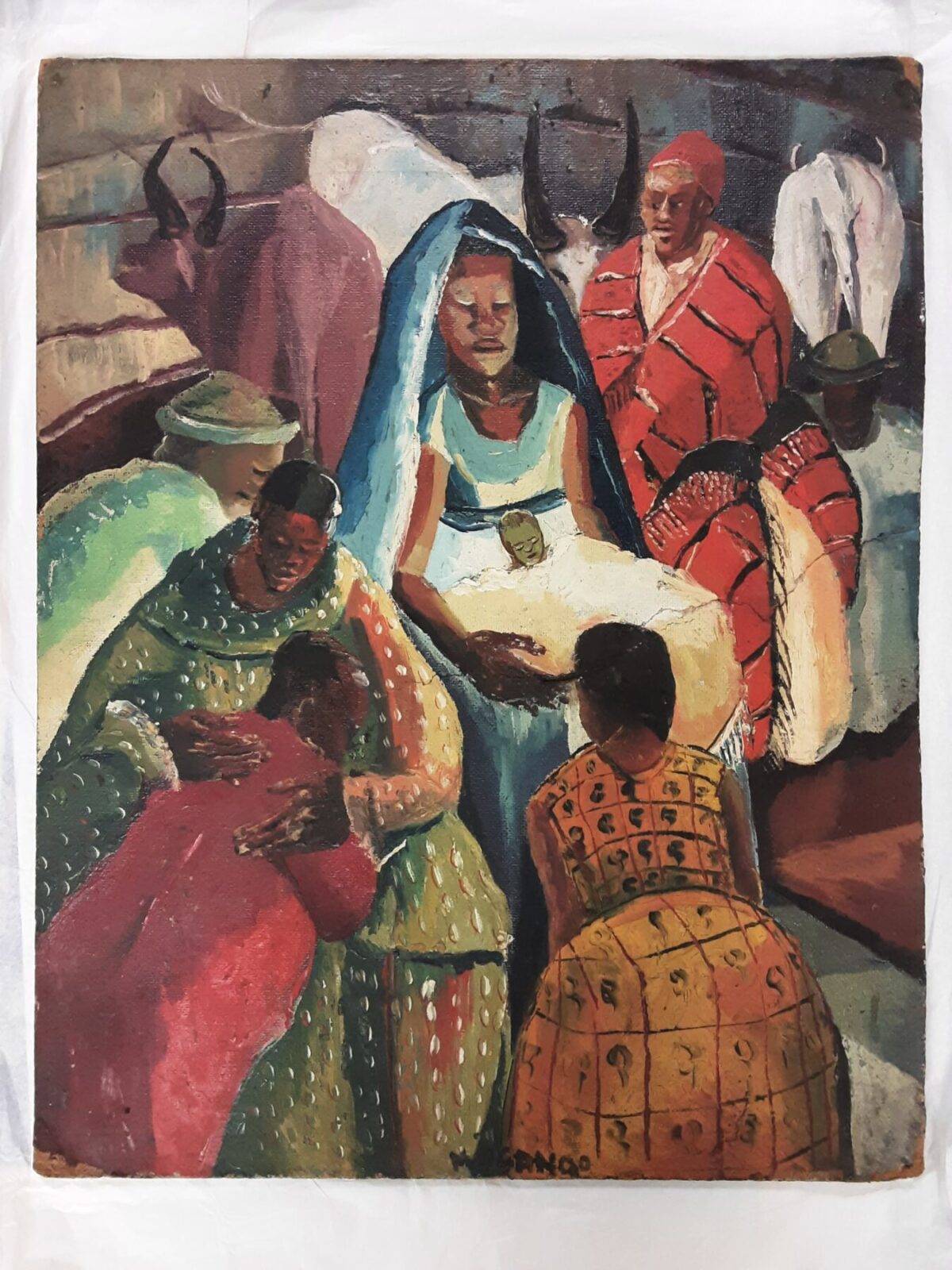
Christ in the Manger by Francis Musangogwantamu (1931-2004), has been nominated as one of Virginia’s Top 10 Most Endangered Artifacts, an annual contest that is sponsored by the Virginia Association of Museums. This painting, which comes from the Hampton University Museum’s Harmon Foundation Modern African Art collection, has been nominated to highlight the need for the conservation and preservation of artworks in this collection.
Since its donation by the Harmon Foundation in 1967, the artworks within the collection have been sporadically studied and exhibited, but never comprehensively inventoried or examined by a conservator, until now, thanks to a partnership with the Chrysler Museum of Art and the Hampton University Museum through the Andrew W. Mellon Foundation. Christ in the Manger, along with nine other selected artifacts from other institutions in Virginia, will be featured in an online public voting competition, which will take place from February 20th to March 3rd, 2024. The artifact that receives the most votes will receive the People’s Choice award, and another artifact will be selected by a panel of conservation experts. The two selected objects will receive $1,000 grants to be put towards the object’s conservation treatment. The other eight objects will receive $250 to be put towards conservation costs or professional development for staff.
The Harmon Foundation Modern African Art Collection

Christ in the Manger by Francis Musangogwantamu was donated to the Hampton University Museum by The Harmon Foundation in 1967. The Harmon Foundation was an organization based in New York City that supported and promoted the work of African and African American artists. It was established in 1922 by a real estate developer and philanthropist William E. Harmon. Around 1925, the foundation started an awards program for excellent achievements by African Americans in a variety of fields, including the visual arts.
Starting in 1928, the foundation arranged traveling exhibitions of art by African Americans, which toured nationwide. During the 1960s, the foundation organized art exhibitions featuring traditional and modern African arts. These shows traveled to various HBCUs, including Hampton University (then called Hampton Institute), to foster interest in Indigenous African cultures among African Americans. The foundation worked to obtain American sponsors for promising African artists and sometimes arranged for some artists to receive further education in the United States. The Harmon Foundation dissolved in 1967, resulting in the donation of their artworks and documents to various institutions, including the Hampton University Museum. To learn more about the history of the Harmon Foundation click here.
Brother Francis Musangogwantamu and a Universal Christ
Brother Francis Musangogwantamu was born in 1931 in a small village near Kampala, Uganda. His interest in art began as a hobby when he started his studies for the Brothers of Christian Instruction. Margaret Trowell, the founder of the art school at Makerere University, now the Margaret Trowell School of Industrial and Fine Arts located in Kampala, recognized Musangogwantamu’s potential as an artist and asked the higher-ups of the Brother of Christian Instruction to send him to Makerere to study. He began his art training at Makerere College in 1954.
Musangogwantamu, a devout Christian created art with “Africanized” Christian iconography. While some accepted Musangogwantamu’s art, others strongly objected to his depiction of Christianity, seeing it as radical. For example, Musangogwantamu had his designs for a mural in a Catholic Cathedral rejected because he depicted Christ as an African man instead of a white man. In response to the notion that Christ could not be African, Musangogwantamu asked, “I wonder…if Christ is not universal?”

In Christ in the Manger, Musangogwantamu depicts a Universal Christ. Christ, who we can assume is sleeping on the lap of his mother, Mary, is the focus of the piece. Christ is positioned in the center of the frame with a heavenly light radiating from his body. Musangogowantamu has painted all the people in the manger Black with brightly patterned clothing and renditions of the Gomesi and Kanzu, traditional women’s and men’s clothing in Uganda. According to Musangogowantamu, “If I can succeed to have many poor people buy works of art – no matter even if it is for a shilling, I am sure I will be satisfied just by the fact a message is being passed on through art.” This quote, in relation to Christ in the Manger, allows us to understand the importance of Musangogowantamu’s depiction of biblical figures as Africans. In doing this, he is practicing self-representation. This piece is meant for Black Africans to see themselves in a religion that usually excludes them in its art. The message he is spreading is if we are all made in God’s image, there is no reason Christ cannot be depicted as African. To learn more about Christian iconography in the collection click here.
Condition
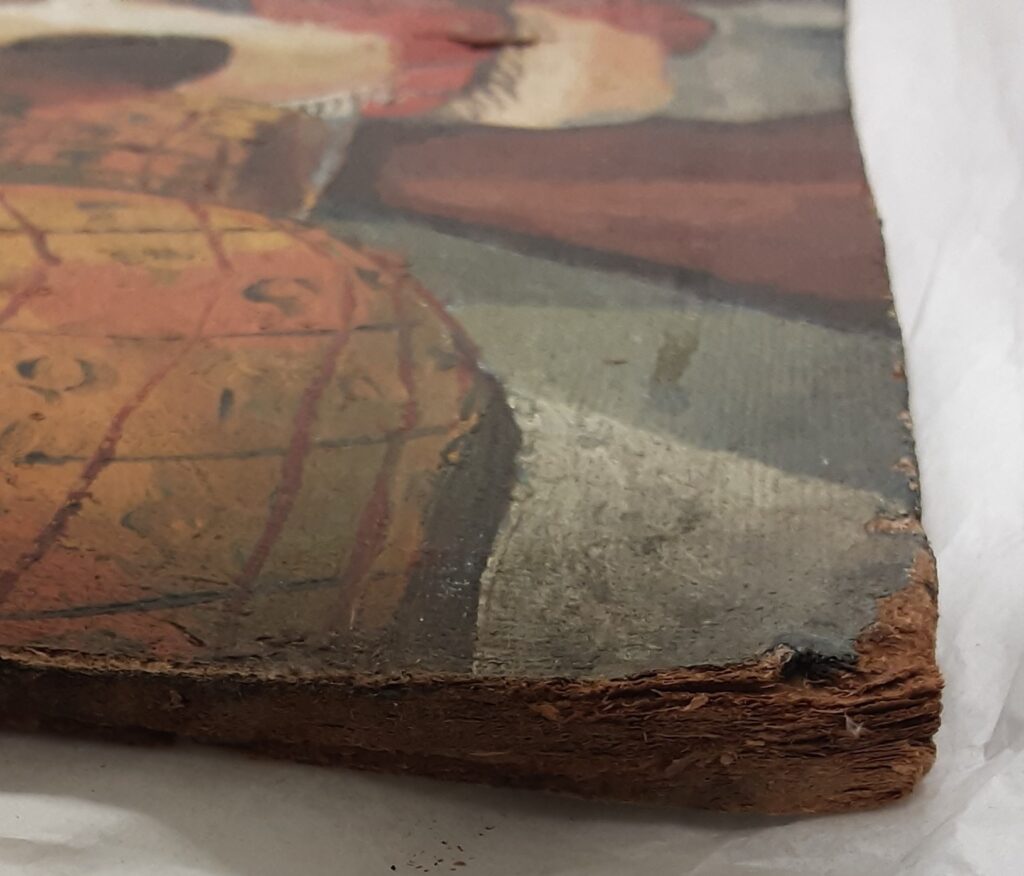
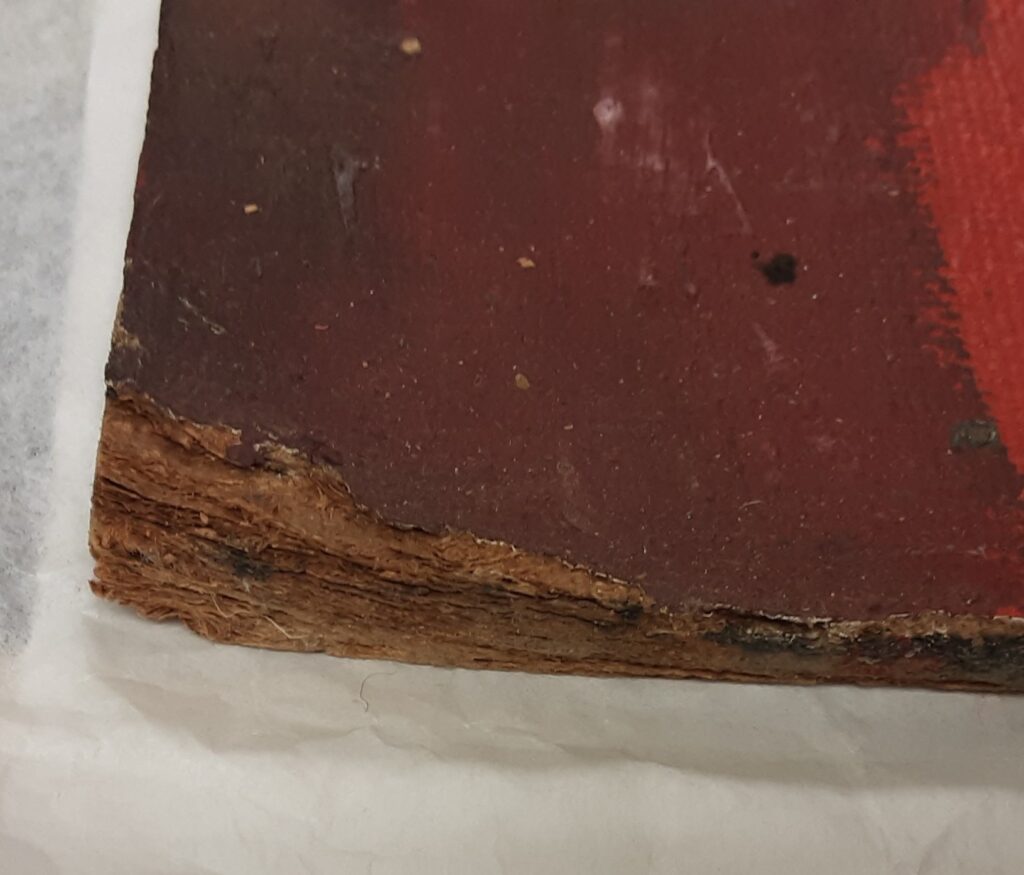
This painting is executed on a support that consists of 2 layers of Masonite board, whose smooth surfaces have been adhered together with an adhesive. The corners of the boards, particularly the upper corners, are splitting apart into layers, or delaminating, and have minor paint losses and distortions. The most pressing condition issue is the large split that runs through the middle of the upper board. This split is about 15 inches long, and has caused parts of the board to be mobile in places, as well as caused areas of the board to not be fully planar. It is likely that the second board was adhered to the upper one after the large split occurred in order to stabilize the damage to the top layer of Masonite, which supports the image. There is also a small split near the center of the proper right edge, about 1 ½ inches long, and nearby a minor loss of both support and paint. Although the painting is not actively deteriorating, its condition makes it difficult to display the piece in the way the artist intended.
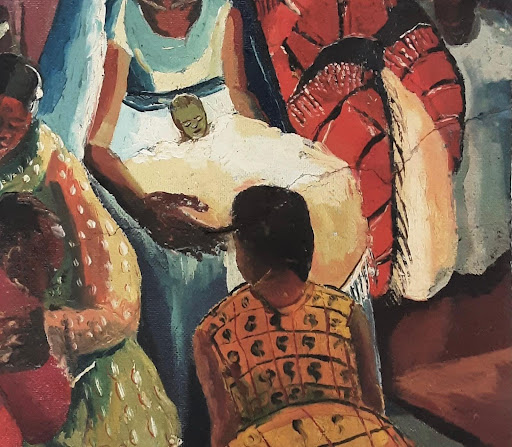
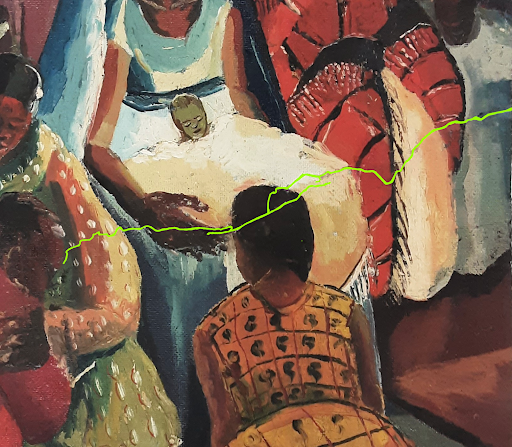
A treatment proposal has been developed by Mark Lewis, conservator at the Chrysler Museum of Art. The delaminating areas of the board should be flattened and re-adhered using a conservation grade adhesive. Unstable paint should be stabilized, and the surface should be cleaned to remove dust and dirt, which should improve the overall appearance. The losses should be stabilized, filled, textured to match the surface, and inpainted using reversible materials.
In the Spring and Summer of 2024, The Chrysler Museum of Art and the Hampton University Museum will open two joint exhibitions curated by Tashae Smith, Andrew W. Mellon curatorial fellow. Both exhibitions will feature artworks from the Hampton University Museum’s Harmon Foundation Modern African Art collection, some of which are actively being conserved by Angie Lopez, Andrew W. Mellon conservation fellow.
Christ in the Manger will be exhibited in the Hampton University Museum’s upcoming exhibition, Sankofa: Constructing Modern African Art. In its current condition, this painting will be displayed inside of a case, with didactics highlighting the conservation efforts and research that have gone into this project. However, it would be ideal to conserve this painting so it can be displayed on a wall, allowing it to be experienced as the artist intended. A comprehensive conservation treatment will allow visitors to see the painting in its full glory without the distraction of a large crack and other distortions. More importantly, this treatment will stabilize the artwork and aid in its long term preservation.
Voting to support the conservation and preservation of Christ in the Manger by Francis Musangogwantamu is now open and will run until March 3rd. Visit this link to cast your vote every 24 hours!
Explore other articles like this
The Andrew W. Mellon Fellowship: Now and Beyond
In this post, I will highlight some of the accomplishments of this project and address two main takeaways that can help those looking to reproduce a similar fellowship program.
Art Spotlight: The Abandoned Hut by Mordecai Buluma
In this blog post Angie and Tashae discuss the symbolism behind The Abandoned Hut by Mordecai Buluma as well as the conservation treatment used to prepare it for exhibition.
Opening of I am Copying Nobody the Art and Political Cartoons of Akinola Lasekan
On April 13, 2024, I Am Copying Nobody: The Art and Political Cartoons of Akinola Lasekan opened at the Chrysler Museum of Art. Here are some highlights from the exhibition.
